Key takeaways:
- Butterflies are essential for biodiversity, acting as pollinators and indicators of environmental health.
- Creating butterfly gardens with native plants and minimizing pesticide use can significantly support butterfly populations.
- Local ecosystems are vital for sustaining butterfly habitats and fostering resilience against climate change.
- Engaging in community conservation efforts enhances awareness and collective action to protect butterfly species.
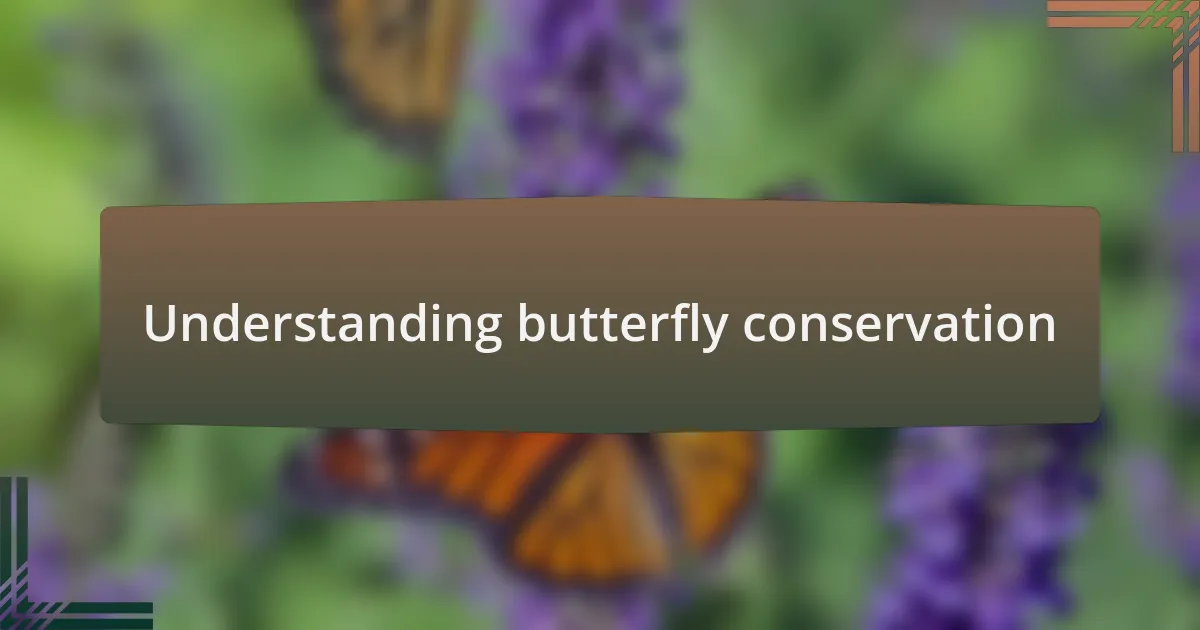
Understanding butterfly conservation
Butterfly conservation is not just an act of kindness; it’s a critical step toward preserving biodiversity. I remember the first time I spotted a Monarch flitting through my garden, its vibrant colors a stark reminder of nature’s beauty. This moment drew me into a deeper understanding of how essential butterflies are to our ecosystem, acting as pollinators and indicators of environmental health.
Have you ever thought about the delicate balance needed to sustain these creatures? Understanding butterfly conservation involves recognizing the challenges they face, from habitat loss to climate change. During a hike last summer, I stumbled upon a once-thriving butterfly habitat now barely a shadow of its former self. It struck me how urgent it is to engage in local conservation efforts, ensuring that future generations can experience the wonder of butterflies.
Every butterfly story is interconnected, and each species plays its unique role in maintaining ecological harmony. When I planted native flowers in my backyard, I noticed an increase in butterfly activity, which filled me with joy. This experience taught me that simple actions can make a big difference in supporting butterfly populations and, by extension, our environment. Isn’t it incredible how a few small changes can lead to profound impacts?
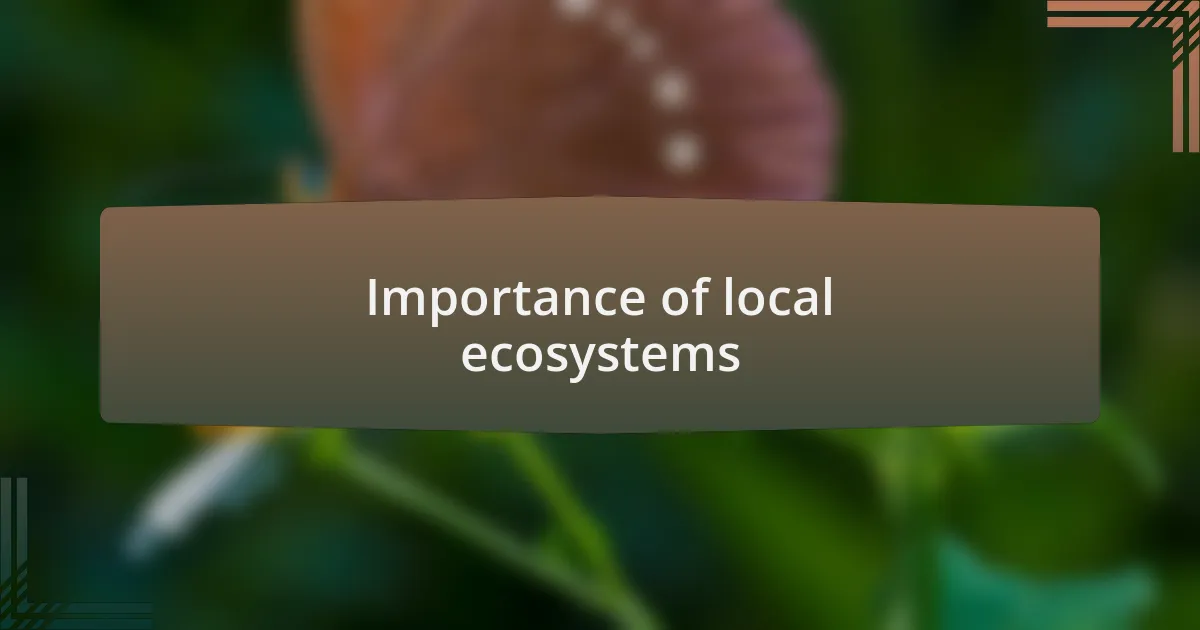
Importance of local ecosystems
Local ecosystems are vital because they provide the foundation for diverse plant and animal life, including the enchanting butterflies we cherish. I recall visiting a local meadow filled with wildflowers; the sheer vibrancy of life was inspiring. That day, I felt an overwhelming sense of connection to everything around me, realizing that each element plays a part in a larger story of survival and balance.
When I think about the intricate relationships within local ecosystems, I can’t help but marvel at how each species contributes to the whole. One afternoon while volunteering at a community garden, I saw firsthand how pollinators like bees and butterflies worked in tandem, ensuring the flowers thrived. It struck me that without these connections, our natural world could unravel, leading to diminished biodiversity.
Local ecosystems also serve as a buffer against climate change, helping to regulate temperatures and manage water resources. I often reflect on how my garden, once just a patch of grass, now acts as a mini-ecosystem that supports various life forms. This transformation made me ponder: what if everyone took steps to cultivate their local environments? Small actions can amplify our collective effort, fostering resilience in the face of environmental challenges.
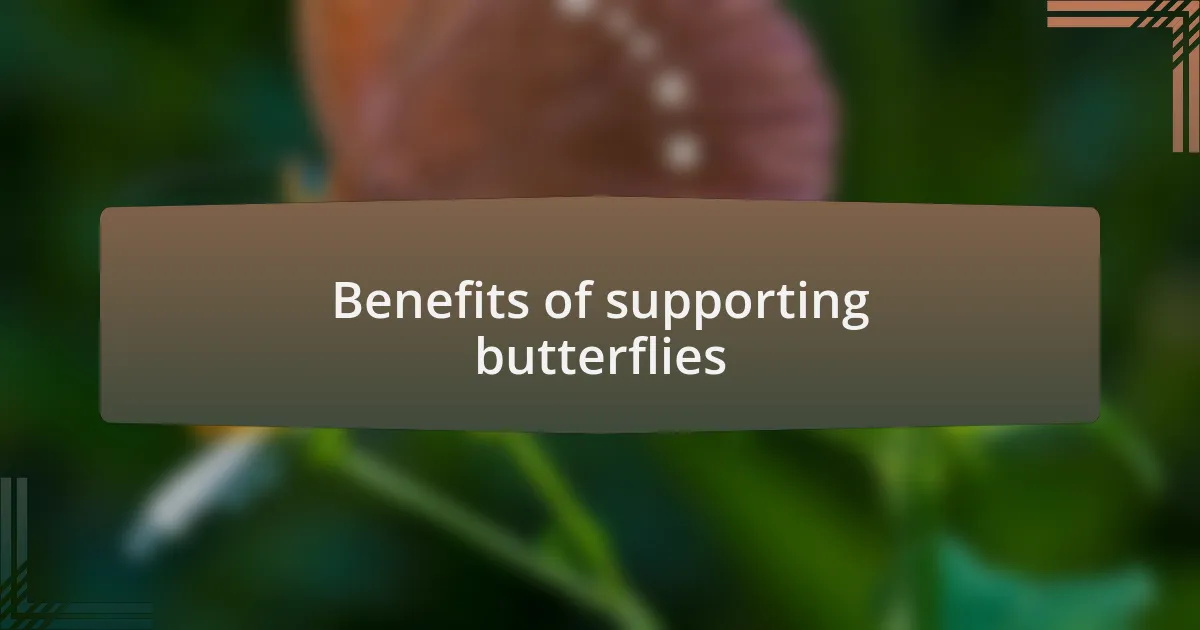
Benefits of supporting butterflies
Supporting butterflies offers numerous benefits that extend beyond their beauty. I remember the first time I noticed a butterfly landing on my sunflowers; it wasn’t just a pretty sight, but a signal that my garden was thriving. Butterflies play a crucial role as pollinators, helping many plants reproduce. When we nurture these delicate creatures, we indirectly support the entire plant community and, in turn, the larger ecosystem.
Moreover, butterflies are indicators of environmental health. I often think about how my morning walks along the local trails have led me to observe various butterfly species. Their presence signifies that the environment is balanced and thriving. If we actively protect their habitats, we are also safeguarding ourselves against the loss of biodiversity and the disruption of our natural surroundings.
I find that supporting butterflies enriches our emotional lives. Just the other day, while sitting in my garden, a bluejay swooped down to join a butterfly dance among the flowers. Watching these interactions brings a sense of peace and connection to nature that we all crave. Have you ever paused to admire these moments? Protecting butterflies gives us not only the joy of witnessing their beauty but a deeper appreciation for our role in the ecosystem.

Best practices for butterfly gardens
Creating a butterfly garden is all about providing the right habitat. I’ve found that the key is to diversify the plants—using a mix of nectar sources, host plants for caterpillars, and a few sheltered spots. For instance, I have a patch of milkweed for monarchs that not only attracts adults but also gives caterpillars a safe place to munch on. Have you ever watched a caterpillar transform? It’s a magical experience that reminds us of nature’s incredible cycles.
It’s also essential to manage your garden without chemicals. A couple of years ago, I was tempted to use a pesticide for pesky aphids, but I quickly realized that doing so would harm more than help. Instead, I embraced natural predators like ladybugs and found that my garden thrived without the harmful effects of chemicals. When did you last trust nature to do its work? Sometimes, letting the ecosystem balance itself can yield the best results.
Adding elements like water sources and sunning spots can enhance your butterfly paradise even further. I remember installing a shallow dish filled with rocks and water, which became a favorite hangout for butterflies on warm days. Their vibrant colors reflected in the water create an enchanting scene. Have you considered how simple additions can transform your space? Making small changes can turn your garden into a sanctuary for these beautiful creatures, encouraging them to return time and time again.
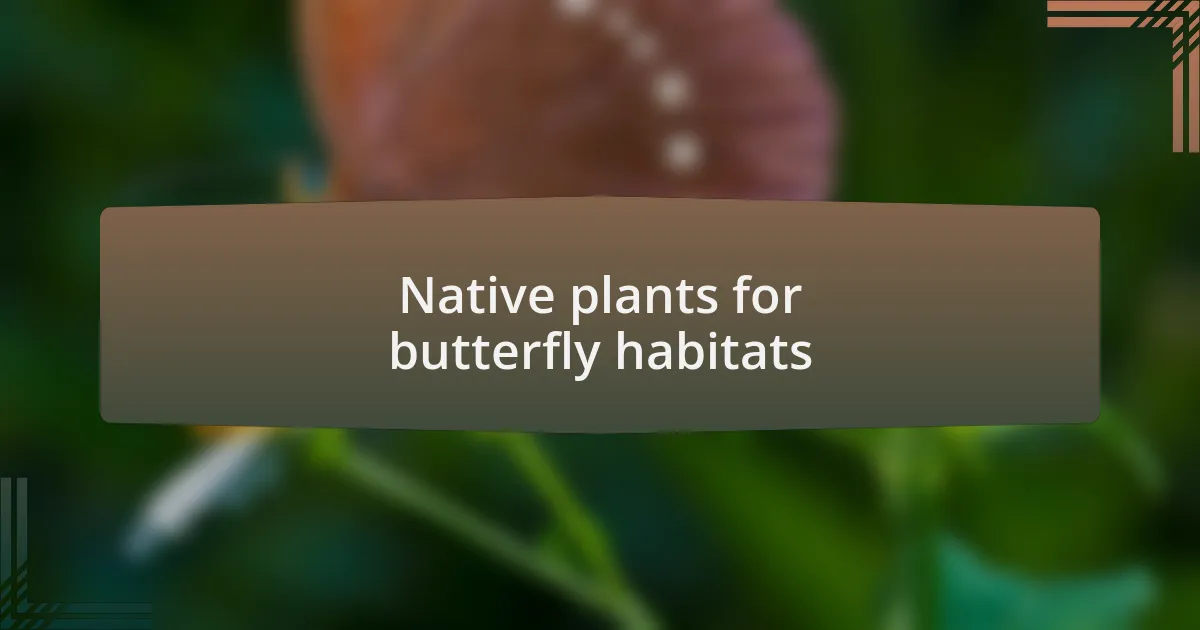
Native plants for butterfly habitats
Native plants play a crucial role in creating and sustaining butterfly habitats. I vividly remember the first time I planted coneflowers and black-eyed Susans; it was like opening a door to a butterfly wonderland. Almost immediately, I noticed an influx of species, each flitting about with purpose. Have you ever stopped to consider how these native plants truly connect the ecosystem?
In my experience, specific host plants are essential for attracting the butterflies that undergo remarkable transformations, like the painted lady butterfly. I dedicated a small corner of my garden to thistle, which turned out to be a beacon for these butterflies to lay their eggs. Witnessing those tiny hatchlings emerge was both a surprise and a joy, highlighting the direct relationship between native flora and butterfly life cycles. Isn’t it fascinating how just a few thoughtfully chosen plants can support such vibrant life?
Furthermore, I can’t stress enough the importance of grouping native plants together. I once created a patch with clusters of asters, which not only looked stunning but became a favorite nectar source for butterflies like the swallowtail. By planting in groups, you increase the chances of butterflies finding and using these plants efficiently. Have you thought about how the arrangement of plants affects butterfly visitation? It’s a small detail that can lead to big rewards in terms of attracting and supporting these beautiful insects.
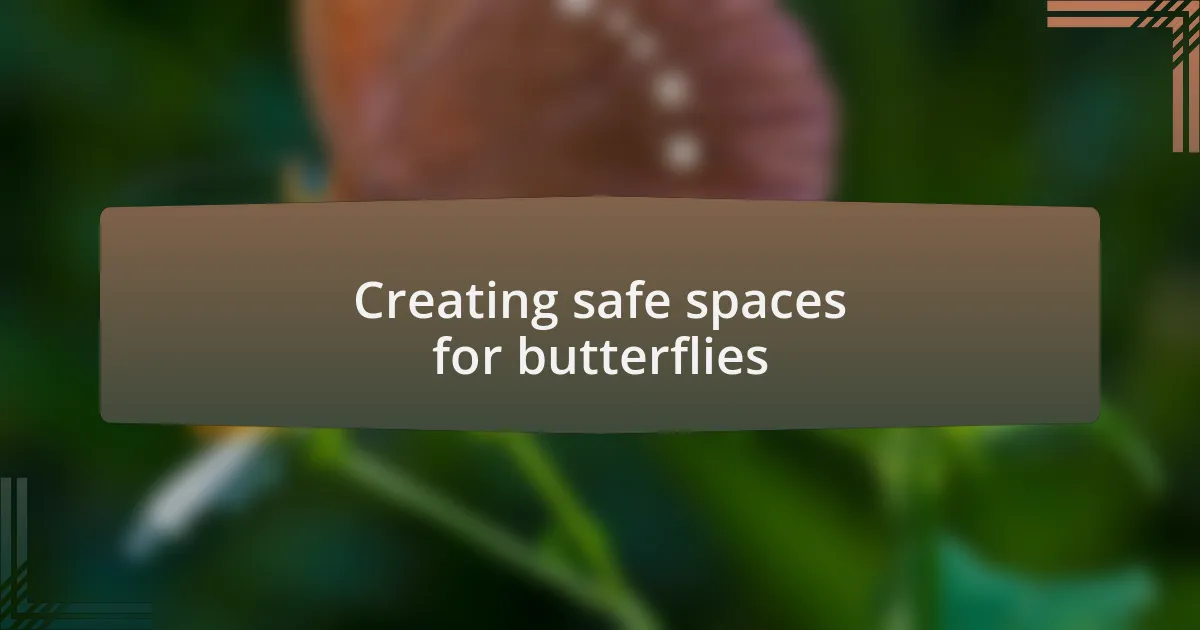
Creating safe spaces for butterflies
Creating safe spaces for butterflies starts with understanding their needs. I have found that incorporating designated butterfly gardens can make a tremendous difference. One afternoon, as I stepped outside, I noticed an area where I had removed the grass to create a small butterfly haven. That very spot was soon alive with butterflies dancing in the sunlight, reminding me how a dedicated space can transform a landscape into a thriving ecosystem.
When I first built a sunflower tower in my backyard, I didn’t fully grasp its potential impact. It became a sanctuary not just for butterflies but also for various pollinators. Sitting on my porch, I would sip my tea, enchanted by the vibrant flutter of wings around me. It made me wonder, how often do we underestimate our ability to create sanctuary just through thoughtful landscaping? The experience clarified the importance of creating multidimensional habitats that encourage diverse butterfly populations.
Moreover, I think it’s essential to consider the borders of these safe spaces. A few years ago, I lined my garden’s edge with a mix of native shrubs and wildflowers. What surprised me was the increase in not just butterfly species, but also bees and other beneficial insects. This simple yet impactful decision left me excited about how interconnected life forms thrive when given a nurturing environment. Have you ever thought about how enriching your garden edges might invite a flurry of life? It’s indeed a rewarding realization.
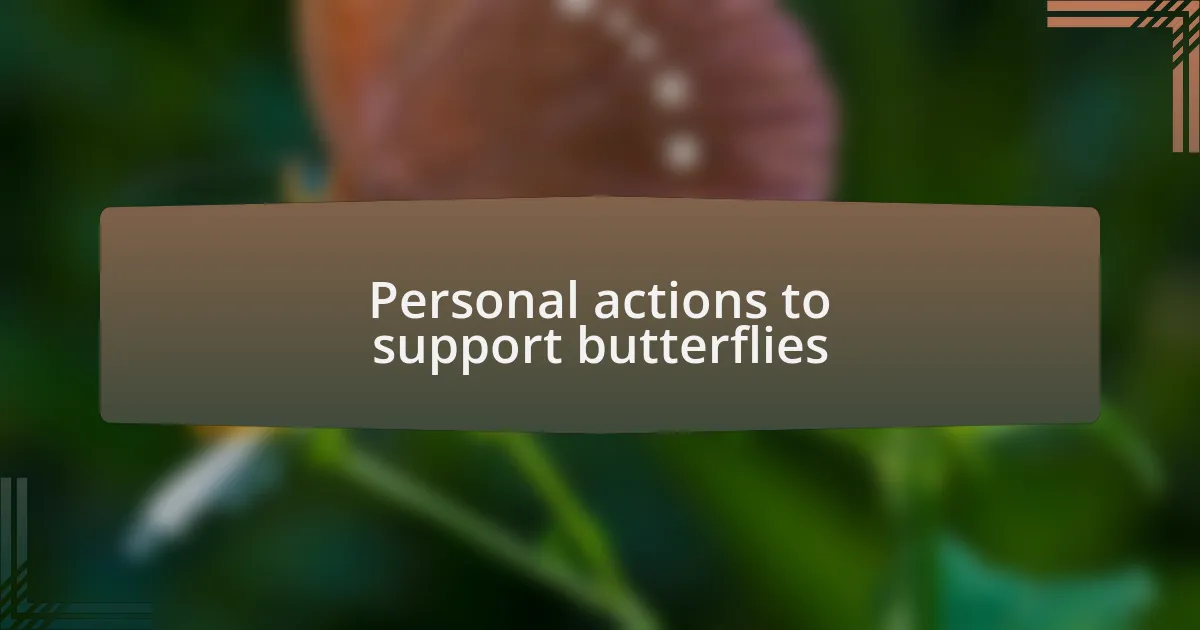
Personal actions to support butterflies
I’ve learned that providing food sources is a critical action to support butterflies. A few years ago, I decided to plant milkweed in my garden, purely captivated by its beauty. As I watched the monarch caterpillars munch happily, I realized I was not just aiding their life cycle but nurturing a connection to nature that filled my heart with joy. Have you ever paused to admire how such a small action can contribute to the survival of these incredible creatures?
Another significant step I’ve taken is to minimize pesticide use. Once, I applied a chemical insecticide, only to witness its devastating effects on not just pesky bugs, but also my butterfly visitors. I quickly changed my approach to organic alternatives, prioritizing harmony over control in my outdoor space. This shift has fostered a space where butterflies not only survive but thrive, reminding me how our choices ripple through the ecosystem. Have you considered how your gardening practices might empower or hinder the butterflies?
Engagement with local conservation efforts has profoundly shaped my journey. Participating in neighborhood butterfly counts has not only expanded my knowledge but also strengthened my community ties. Sharing experiences with fellow enthusiasts helps me feel less isolated in my efforts. What I’ve discovered is that when we unite in purpose, each butterfly sighting becomes a collective victory, igniting our passion to protect these delicate pollinators further. How involved are you in your local conservation community?